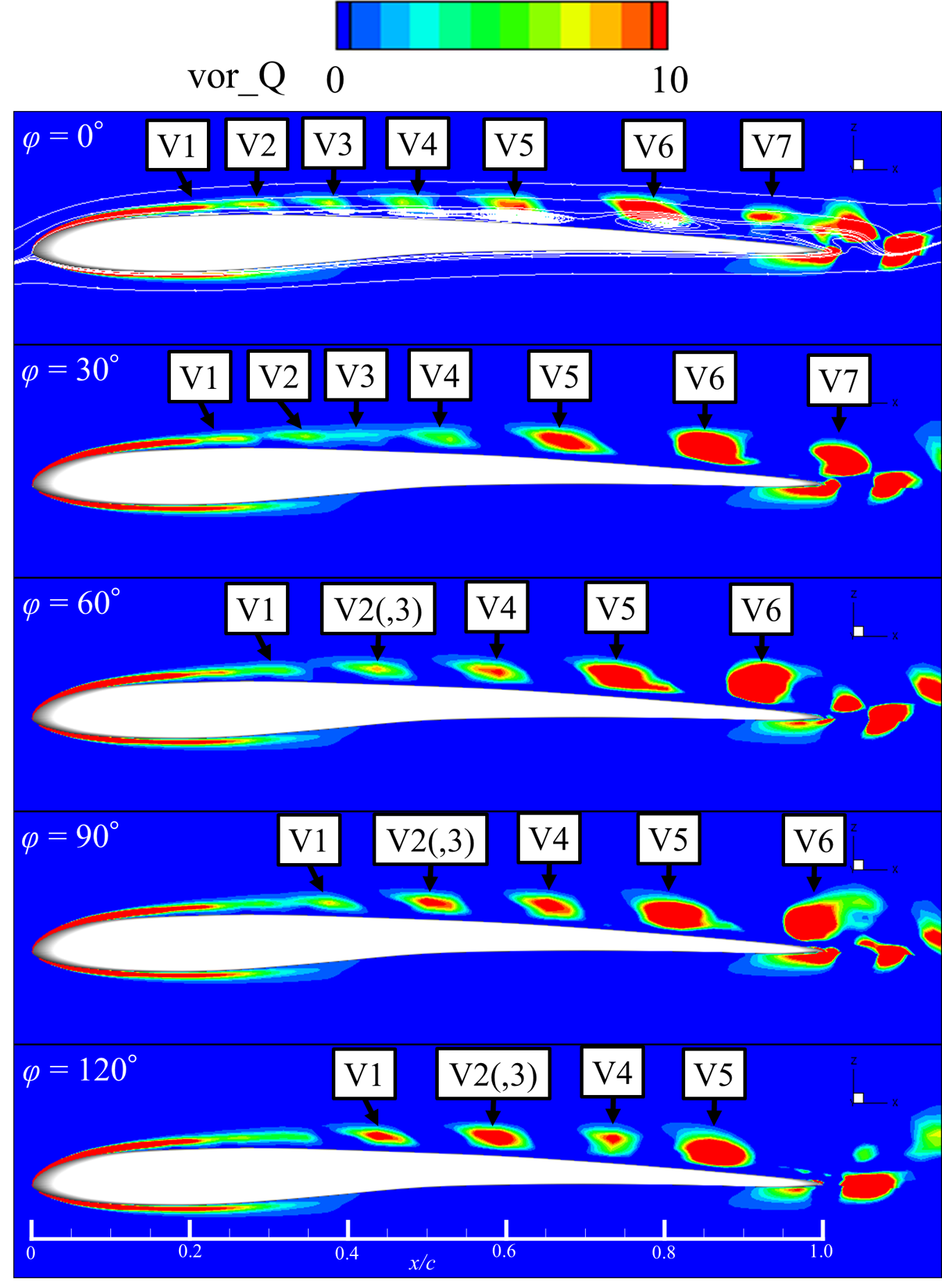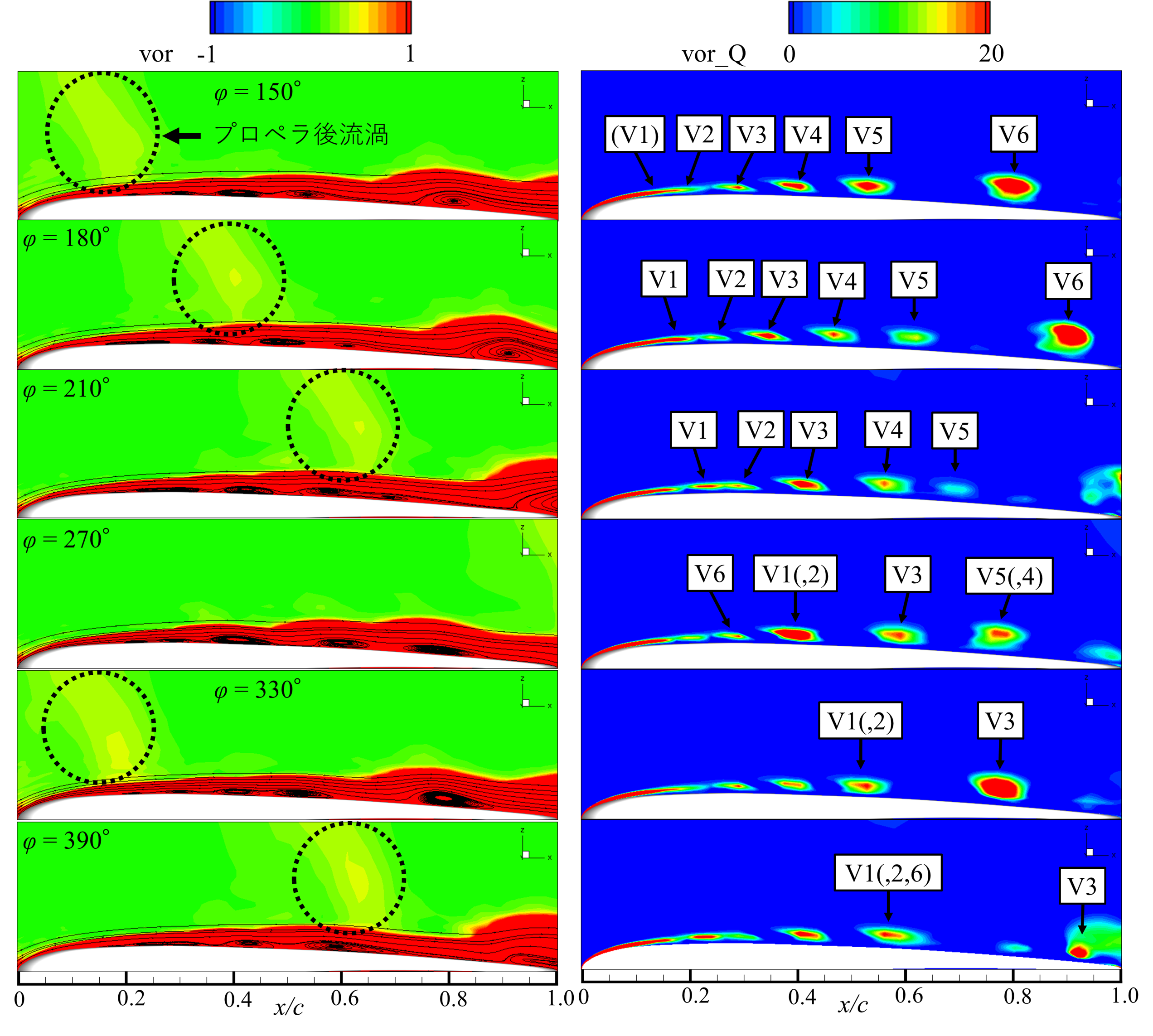Numerical Study on Effects of Propeller to Fixed Wing at Low Reynolds Number
JAXA Supercomputer System Annual Report April 2020-March 2021
Report Number: R20EACA43
Subject Category: JSS Inter-University Research
- Responsible Representative: Keiichi Kitamura, Associate professor, Yokohama National University
- Contact Information: Yoshikatsu Furusawa(furusawa-yoshikatsu-vz@ynu.jp)
- Members: Keiichi Kitamura, Yoshikatsu Furusawa
Abstract
As a new form of a Mars exploration vehicle, research and development of a Mars airplane are progressing. Since the Martian atmosphere is low density and the Mars airplane flies in the low Reynolds number region, the flow field around the Mars airplane differs from airplanes flying in the Earth atmosphere. Besides, the Mars airplane employs propeller-driven, and it is known that propeller slipstream interacts with the fixed-wing and improves aerodynamic performances. However, the detail of the interaction mechanism has not been clarified. In the present study, we conduct numerical simulations and intend to clarify the unsteady effects of propeller slipstream to the fixed-wing at the low Reynolds number region.
Reference URL
N/A
Reasons and benefits of using JAXA Supercomputer System
We used JSS2 to perform large-scale three-dimensional numerical simulations using the flow analysis solver "rFlow3D" and "FaSTAR" developed by JAXA. JSS2 can perform fast and multiple calculations.
Achievements of the Year
In this work, we carried out unsteady numerical calculations simulating the wind tunnel experiments conducted at Tohoku University (Re = 30,000). To simulate various flight conditions, the propeller rotation speed (n = 4500, 6000, 9000 rpm) and the advance ratio (J = 0.8, 0.6, 0.4) were varied. The angle of attack was set to 5 deg.
Figure 1 shows the Q-criterion contours around fixed-wing in the case of without propeller. In this figure, the time step is indicated by the propeller azimuth angle of J = 0.8. High Q-criterion regions are separation vortices rolled up from the separation shear layer around the leading edge. When the propeller is not installed, generated separation vortices grow toward the trailing edge and spill out from there.
Figure 2 shows the vorticity contours (left) and Q-criterion contours (right) of J = 0.8. The high vorticity regions in the vorticity contour highlighted by dashed lines indicate the continuous vortices generated from the blade trailing edge. This vortex is called the propeller slipstream vortex below. From fig. 2, the vortex, which is formed just after the propeller slipstream vortex passed the searation shear layer, has intense vortex structure even just after the generation and moves to the trailing edge merging with around vortices. It is considered that the propeller slipstream vortices interact with the separation shear layer as a disturbance, and then the inner unsteadiness of the separation shear layer will be augmented.
Publications
- Oral Presentations
Yoshikatsu Furusawa, Keiichi Kitamura, Hiroki Nagai, Akira Oyama, "Numerical Study on Propeller Slipstream Effect on Fixed Wing with Different Advance Ratio," JSASS-2020-4042, 2020 (in Japanese)
Yoshikatsu Furusawa, Keiichi Kitamura, Hiroki Nagai, Akira Oyama, "Numerical Study on Propeller Slipstream Effect on Laminar Separation Bubble over Fixed Wing at Low Reynolds Number," JSASS-2020-5045, 2020 (in Japanese)
Yoshikatsu Furusawa, Keiichi Kitamura, Hiroki Nagai, Akira Oyama, "Numerical Investigation on Three-Dimensional Flow Structure over Fixed Wing within Propeller Slipstream," 17th International Conference on Fluid Dynamics, 2020
Usage of JSS
Computational Information
- Process Parallelization Methods: MPI
- Thread Parallelization Methods: OpenMP
- Number of Processes: 1 - 512
- Elapsed Time per Case: 480 Hour(s)
Resources Used(JSS2)
Fraction of Usage in Total Resources*1(%): 0.08
Details
Please refer to System Configuration of JSS2 for the system configuration and major specifications of JSS2.
| System Name | Amount of Core Time(core x hours) | Fraction of Usage*2(%) |
|---|---|---|
| SORA-MA | 0.00 | 0.00 |
| SORA-PP | 117,040.04 | 0.92 |
| SORA-LM | 0.00 | 0.00 |
| SORA-TPP | 0.00 | 0.00 |
| File System Name | Storage Assigned(GiB) | Fraction of Usage*2(%) |
|---|---|---|
| /home | 6.68 | 0.01 |
| /data | 4,901.89 | 0.09 |
| /ltmp | 1,367.19 | 0.12 |
| Archiver Name | Storage Used(TiB) | Fraction of Usage*2(%) |
|---|---|---|
| J-SPACE | 3.30 | 0.11 |
*1: Fraction of Usage in Total Resources: Weighted average of three resource types (Computing, File System, and Archiver).
*2: Fraction of Usage:Percentage of usage relative to each resource used in one year.
Resources Used(JSS3)
Fraction of Usage in Total Resources*1(%): 0.14
Details
Please refer to System Configuration of JSS3 for the system configuration and major specifications of JSS3.
| System Name | Amount of Core Time(core x hours) | Fraction of Usage*2(%) |
|---|---|---|
| TOKI-SORA | 120.87 | 0.00 |
| TOKI-RURI | 211,181.85 | 1.21 |
| TOKI-TRURI | 0.00 | 0.00 |
| File System Name | Storage Assigned(GiB) | Fraction of Usage*2(%) |
|---|---|---|
| /home | 6.68 | 0.00 |
| /data | 14,667.52 | 0.25 |
| /ssd | 2,460.48 | 1.28 |
| Archiver Name | Storage Used(TiB) | Fraction of Usage*2(%) |
|---|---|---|
| J-SPACE | 3.30 | 0.11 |
*1: Fraction of Usage in Total Resources: Weighted average of three resource types (Computing, File System, and Archiver).
*2: Fraction of Usage:Percentage of usage relative to each resource used in one year.
JAXA Supercomputer System Annual Report April 2020-March 2021




